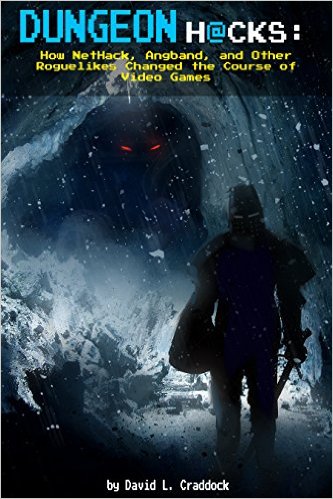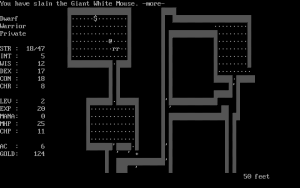Book Impressions: Dungeon Hacks
Posted by Rampant Coyote on August 31, 2015
 Except for a fairly lame mail-order game from Aardvark Software, my first computer role-playing game was Telengard for the Commodore 64. We didn’t have the modern taxonomy of games like we do now… I don’t know if “role-playing game” had really caught on then. “Roguelike” certainly hadn’t. Both words would have applied, but at the time, it was a D&D style game, and that was good enough for me. I spent hours and hours delving through the giant procedurally-generated dungeon.
Except for a fairly lame mail-order game from Aardvark Software, my first computer role-playing game was Telengard for the Commodore 64. We didn’t have the modern taxonomy of games like we do now… I don’t know if “role-playing game” had really caught on then. “Roguelike” certainly hadn’t. Both words would have applied, but at the time, it was a D&D style game, and that was good enough for me. I spent hours and hours delving through the giant procedurally-generated dungeon.
I didn’t know at the time that Telengard was heavily derived from a game on larger mainframe or mini-computers. But what I did learn was that the code was written in BASIC, which I was able to break into and examine in great detail to see how this giant dungeon with levels of 100 x 100 rooms could actually fit inside the 64K Commodore 64. That part wasn’t random – the maps never changed, but were rather calculated by a formula. But the content within the maps changed constantly. While it might not fully qualify, I consider it my first introduction to roguelikes.
My real introduction to roguelikes came several years later, with Moria. I never mastered it, never fought the Balrog, but I again spent many, many hours delving its secrets. While I found out later that Angband was its spiritual descendant, I never got into the latter game. At least not yet. While I’d briefly experienced other roguelikes, it was the one that “stuck” for me. In a lot of ways, it might have been because I didn’t think of it as a roguelike – I was thinking of it as an RPG.
Things have diverged a bit since then, with many roguelikes taking a more mathematically pure game-like approach, and others sticking with the more simulation-esque general RPG approach, some getting simpler, and others really going off in totally new directions while borrowing some of the key features from this family of games (the so called “roguelike-likes,” or as one friend coined the phrase, “Procedural Death Labyrinths”).
Last week I stumbled over a book that details some of the key games of the field, covering their history, interviewing key developers, and explaining what they added to the “mix” of roguelikes in the future. Well, duh, how could I resist:
Dungeon Hacks – How Nethack, Angband, and other Roguelikes Changed the Course of Video Games, is by David L Craddock. It’s divided into several sections. The main section goes chapter by chapter detailing various key historical “roguelikes” – including the games that preceded Rogue and of course Rogue itself. The chapters also have links to “Side Quests” – pieces of interesting history or trivia that didn’t belong in the main section, but could have easily been “sidebar” information. Finally, there is a section called “Bonus Round” that includes interviews with other people more peripherally involved in the history, and excerpts from other books.
My biggest words of praise for this book is the amount of effort the author must have taken to get in touch with these game developers and piecing together their stories – often dating back 35 years or more. I’ve always been interested in the story behind the development of games, even before I was a game developer myself. That’s probably a big part of the reason I decided to go into game development in the first place.
 So if you are into that kind of thing, while the stories aren’t generally full of drama, they do offer fascinating insight into the people and the designs of these awesome classic titles. They offer insight as to why they were made the way they did, how people responded, what inspired the developers, and occasional bits of interpersonal struggles between the developers.
So if you are into that kind of thing, while the stories aren’t generally full of drama, they do offer fascinating insight into the people and the designs of these awesome classic titles. They offer insight as to why they were made the way they did, how people responded, what inspired the developers, and occasional bits of interpersonal struggles between the developers.
The “Side Quest” bits are fascinating excursions on their own. Some chapters contain lots of entries, others none or only one. But there’s little bits about the difficulty of sending software behind the Iron Curtain in the 1980s, or the “Lost” version 5.0 of Moria, or tidbits about the limitations of the technology or the weird university policies the developers had to contend with.
My one complaint would be that the promise of the title – how the key titles in the roguelike genre “changed the course of video games” – is largely unfulfilled. There is mention of some of the derived / inspired titles that have gained popularity today – the Diablo series, FTL, etc., but that’s largely left implied. As to course-changing… well, that might have been a bit overstated. I’d have liked to see more quotes from major game developers in the AAA and indie space today about how they were inspired by roguelikes or how a roguelike influenced their own designs. But admittedly, this is more of a quibble.
Anyway, it’s probably pretty obvious if the book would appeal to you or not. If you are interested in the history of the development of games, particularly RPGs and roguelikes, this is for you. If you are a roguelike fan, then you may be interested in the stories behind the development of the genre. If you are reading this and wondering “What’s a roguelike?” then I obviously I need to do my job better (although that question has some really contentious answers…).
Bottom line: I liked it, and it made me want to take a stab at building a roguelike more than ever. Maybe I’ll take some time out during the next 7DRL challenge, if it’s not coinciding with some major life event this time.
Filed Under: Books, Roguelikes - Comments: 2 Comments to Read
McTeddy said,
You know, I really want to take part in a 7DRL one year too. Haven’t been able to pull one off yet and I SUCK at procedural dungeons.
I love the genre, I’m just lousy at making them.
Rampant Coyote said,
Last year I worked on a full 3D procedural dungeon generator. I didn’t devote too much time to it, but I wanted to test out some ideas. While it’s promising, it also taught me that it was a lot more complicated than I’d given it credit for.